Archaeological Institute of America
Deadline: September 15, 2025
The Conservation and Site Preservation Committee invites nominations for the Conservation and Heritage Management Award. This award is made in recognition of an individual’s or institution’s exceptional achievement in any of the following areas:
1) Archaeological conservation (the conservation of an artifact, monument, or site); 2) Archaeological conservation science (an advance in deterioration analysis or treatment of archaeological materials); 3) Archaeological heritage management (the overall management of a site or group of sites including their preservation and interpretation to the public); 4) Education/public awareness of archaeological conservation through teaching, lecturing, and exhibition, or a publication.
The Award is open to any individuals, institutions, or organizations, public or private, who merit recognition for their contributions to the preservation of our archaeological heritage. Eligibility is not restricted to members of the AIA or to U.S. citizens.
Notifications Procedure
The committee will review nominations and make a decision by October. This decision then needs to be approved by the AIA’s Governing Board. In November, AIA Staff will contact all nominators regarding the status of their nomination. The winner will be celebrated at the Awards Ceremony in January.
Please send name, CV, and two or more letters of recommendation to awards@archaeological.org.
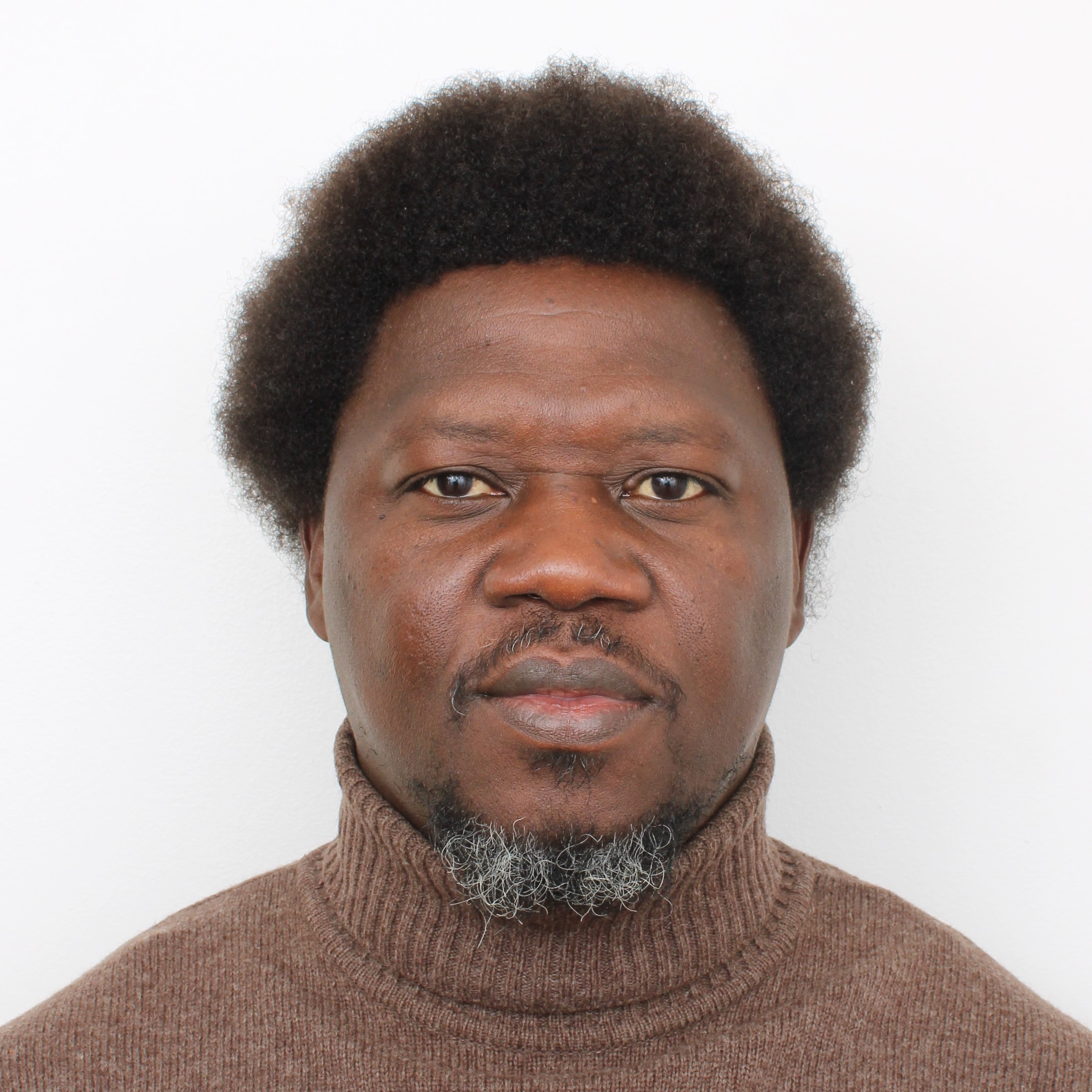
2025
The Archaeological Institute of America is pleased to present the 2025 Conservation and Heritage Management Award to Dr. Abidemi Babatunde Babalola, Research Archaeologist at the Department of Africa, Oceania and the Americas, at the British Museum, London. Dr. Babalola earned both his B.A. and M.A. at the Department of Archaeology and Anthropology, University of Ibadan, Nigeria. He received another Master’s degree as well as his Ph.D. in Anthropology from Rice University, Houston, Texas. Between 2016 and 2024, he held numerous prestigious fellowships, including the Marie Skłodowska-Curie Fellowship at the Cyprus Institute, Cyprus (2022–2024) and Andrew Mellon Postdoctoral Fellowship at the British Museum (2021–2023).
Dr. Babalola is a highly successful archaeologist and anthropologist and has been serving as the director of the Archaeology of Glass Project at Ile-Ife in South West Nigeria since 2010. This project investigates the technologies and production of glass in Sub-Saharan Africa, focusing on the remarkable site of Olokun Grove (Igbo Olokun) in Ile-Ife, located south of the River Niger and dated between the eleventh and fourteenth centuries CE. The significance of the Igbo Olokun site is noted by scholars as a unique site in Sub-Saharan Africa, where indigenous glass-making technology is documented, thanks to the pioneering work of Dr. Babalola. Dr. Babalola and his team’s archaeological and conservation work has demonstrated the complexity of the site and its independently developed technologies linked to the social organization of production, trade, and exchange in the Yoruba-Edo region of Nigeria.
What particularly impressed AIA’s Cultural Heritage Committee was Dr. Babalola’s work at the Igbo Olokun site beyond the scientific study of glass technologies and conservation of a massive assemblage of artifacts and technological installations: the cultural heritage management of the archaeological site, public archaeology, and the passionate engagement of local stakeholders in the preservation of the site. Thanks to Dr. Babalola’s efforts since 2017, Igbo Olokun has been transformed into a site of community engagement and exemplary heritage management. This has included mobilizing the local stakeholders to conserve the excavated eleventh-century glass-making furnace pits, build a roof cover to protect the excavated trenches, plant native vegetation around the site, install informative panels and display boxes for the artifacts, and hire a guard to secure the site. Dr. Babalola’s work at Igbo Olokun offers archaeologists an exemplary model for effective conservation and management of archaeological sites through a genuine engagement with stakeholders.
2021-2024
No winners were selected during this time.
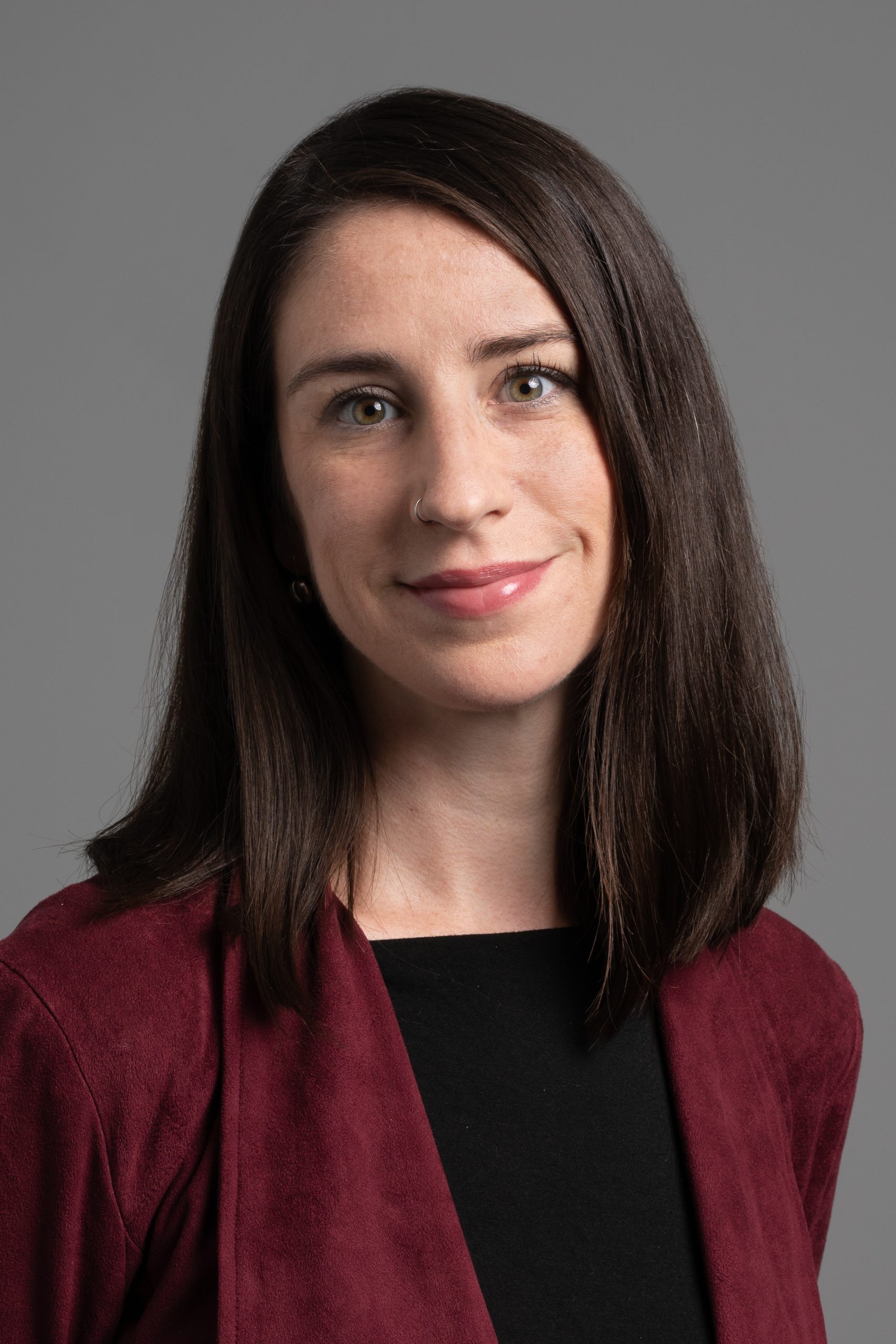
2020
The Archaeological Institute of America is pleased to present the 2020 Conservation and Heritage Management Award to Dr. Katherine Miller Wolf. Miller Wolf earned her B.A. in Anthropology and both her M.A. and Ph.D. in Anthropology from Arizona State University. Currently, she is tenured at the University of West Florida, having prior been a professor at Indiana University East.
Miller Wolf is an extremely capable bioarchaeologist, who in 2004 launched a massive conservation project involving over 1,200 ancient Maya human skeletal remains, at Copan, Honduras. Miller Wolf’s work at Copan involved going through every single burial housed at the site of Copan – collected during excavations dating from present-day back through to the 1890s – and re-cataloging, tagging, bagging, and boxing them based on excavation. She has spent the past decade and a half completely overhauling the collection and standardizing it for long-term curation and research use.
Currently, Miller Wolf is utilizing her model of conservation for Copan and working on a conservation and rehousing project for the remains of over 250 Maya individuals housed in the Three Rivers Region Belize, the largest skeletal collection in the country of Belize. Since 2016, she has worked on the conservation of remains in Belize City as well – a historical sample representing about 75 individuals of African, Maya, and European descent.
Among Miller Wolf’s publications, she has edited a complete volume of Advances of Archaeological Practice (7(1)2019) and was also the author and co-author of several articles within that issue. That volume focuses on conservation strategies for human remains. She is also co-authoring a chapter in an upcoming book on northwest Belize from the University of Florida Press, focusing on ethics and conservation in bioarchaeology.
Miller Wolf is an immensely talented, ethical, and kind bioarchaeologist whose conservation strategies have helped to change three highly at risk skeletal collections and secured them for curation in the long-term. We are delighted to honor her with the AIA’s Conservation and Heritage Management Award.
2017-2019
No winners were selected during this time.

2016
Accepted by Susan Hughes
The Archaeological Institute of America presents the 2016 Conservation and Heritage Management Award to the City of Toronto’s Heritage Preservation Services and the archaeological and cultural heritage consultancy, ASI. The two groups are being recognized for their work in developing, implementing and maintaining an Archaeological Management Plan for the City of Toronto.
The Archaeological Management Plan is used to identify land developments that have the potential to impact archaeological sites and should, therefore, be subject to archaeological assessment. The plan incorporates predictive models to record Toronto’s known and potential archaeological resources and defines the process by which sites should be identified, evaluated and mitigated. The plan is a proactive and visionary archaeological management practice that exceeds legislative requirements and was developed and implemented at a scale unseen in other jurisdictions. The City of Toronto has recognized the importance of this model and is particularly rigorous in the application of it.
The management plan also includes provisions for interpretation and commemoration. The City of Toronto requires developers to fund and maintain permanent commemorative and interpretive displays related to the heritage and archaeology of their properties. This interpretative display initiative is, again, not a legal requirement of the province but an independent requisite of the city to engage the public in the appreciation of heritage.
Aspects of the City of Toronto Archaeological Management Plan have been used as models for other municipalities in the province of Ontario. The Conservation and Site Preservation Committee hopes that this successful embrace of old and new inspires more and more municipalities to preserve their archaeological heritage as they plan for the future.
For all these reasons, the Archaeological Institute of America is pleased to present the 2016 Conservation and Heritage Management Award to the City of Toronto’s Heritage Preservation Services Unit and the archaeological and cultural heritage consultancy, ASI.
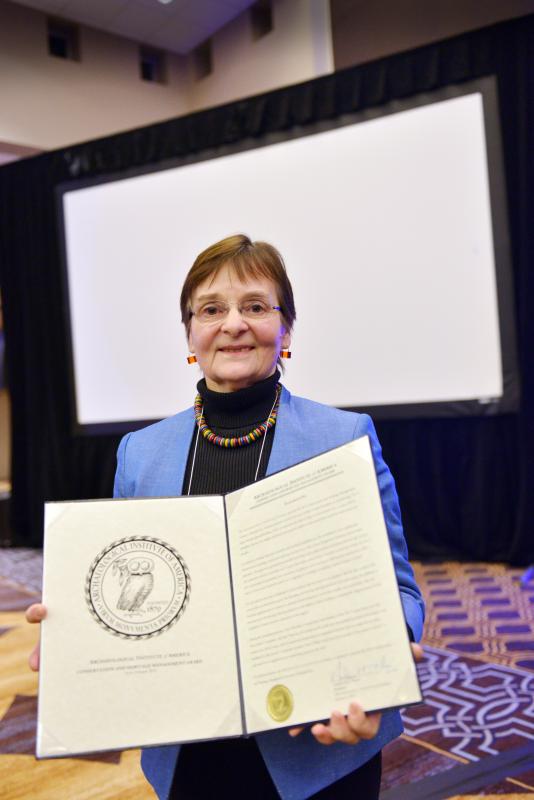
2015
The Archaeological Institute of America presents the 2015 Conservation and Heritage Management Award to Elizabeth Pye, emeritus professor at the University College London Institute of Archaeology. Pye’s legacy includes groundbreaking efforts to transform the field of objects conservation into a science-based discipline. She has also taught, mentored, and inspired students from around the world for more than four decades.
In addition to making important scientific and technical contributions, Pye established a new intellectual framework for teaching conservation and has become one of the United Kingdom’s foremost conservation educators. Her approach, grounded in scientific knowledge and a philosophical and ethical framework, focuses on community-minded, accessible, and socially responsible conservation. Countries around the world owe Pye a debt of gratitude for populating their museums, art galleries, and excavations with trained conservation staff—many of whom have themselves gone on to organize or contribute to training courses in their countries.
It is not only for the years of dedication to her students that Pye deserves recognition. She has also worked with conservation professionals to grow the discipline and develop national standards for conservation. In addition to receiving appointments to numerous national and international conservation bodies and committees, she was instrumental in developing training programs in sub-Saharan Africa, leading to considerable improvements in the conditions of many museum collections in that region.
During the nomination process, Alice Paterakis, a conservator and member of the AIA Conservation and Site Preservation Committee, said that “there are few people in the world who are qualified as both archaeologist and conservator. [Pye’s] many years of experience promoting the integration between the two make her an ideal candidate for this award.” Committee member Nancy Wilkie noted that Pye’s receipt of the award would be “well-deserved recognition for an outstanding person in the field.”
For all these reasons, the Archaeological Institute of America is pleased to present the 2015 Conservation and Heritage Management Award to Elizabeth Pye.
Read more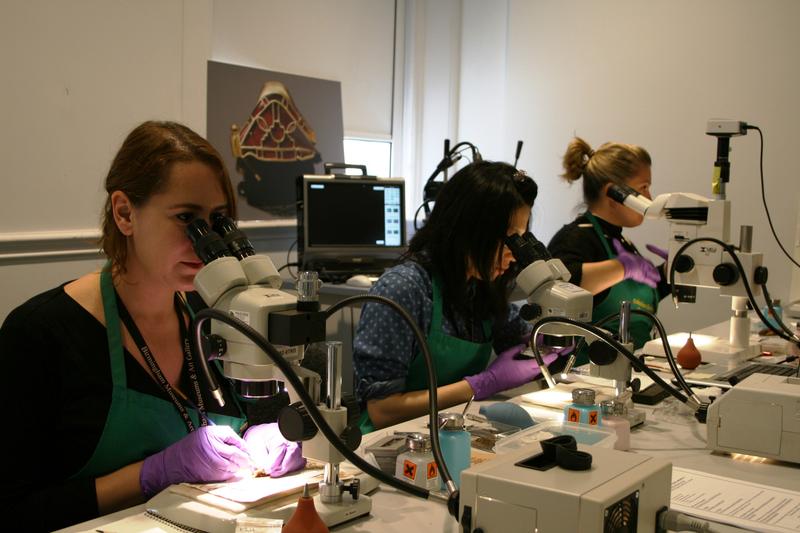
2014
The Archaeological Institute of America is pleased to present the 2014 Conservation and Heritage Management Award to the Staffordshire Hoard Conservation Project (SHCP) for its excellent work on the conservation of the spectacular Anglo-Saxon artifacts found in Staffordshire, United Kingdom, and for its associated public education programs.
SHCP is a unique project executed by the Birmingham Museums and Art Gallery. Since its inception in 2010, the project has used an innovative, team-based approach to conservation. The team has conserved the Anglo-Saxon gold and garnet artifacts to the highest standard, and the project has given more than 20 students the opportunity to learn from scholars and from handling the hoard itself.
Because of the immense interest in the hoard, SHCP made it a priority to involve the public in conservation efforts. Public programs included open lectures, studio tours, family days, and written and video blogs that created a supportive public community. These efforts have reached thousands of people, who have become engaged with the project.
The 2014 Conservation and Heritage Management Award recognizes the inspiring efforts of the Staffordshire Hoard Conservation Project in the domains of conservation and public outreach.
Read more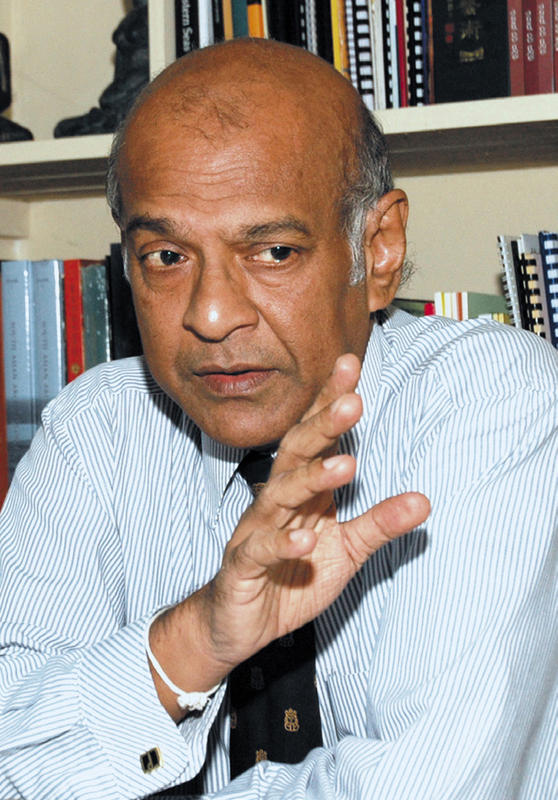
2013
The Archaeological Institute of America is pleased to present the 2013 Conservation and Heritage Management Award for excellence in the conservation of archaeological sites and collections to Sudharshan Seneviratne in recognition of his tireless efforts to protect and preserve the archaeological heritage of Sri Lanka.
Seneviratne’s efforts include archaeological conservation, advocacy, education and training, and cultural-awareness raising. As archaeological director of the Jetavana Project at Anuradhapura, Seneviratne worked on the conservation of the Jetavana stupa, the largest masonry structure in Sri Lanka. Under his direction, the displays in the site museum were reorganized to emphasize the multicultural, multireligious, and commercial aspects of the site rather than simply its role as a Buddhist “monastic city.”
His other projects include the Kandy Heritage City Cultural Mapping Project; the creation of the Ethnographic Museum for Plantation Workers of Indian Origin; and the conservation of the Dutch Warehouse in the Galle Fort, which now serves as the National Maritime Archaeological Museum. Among its displays are reproductions of archaeological objects made in the recently established Antiquities Replica Centre of the Central Cultural Fund, where young artisans are trained in traditional Sri Lankan arts and crafts.
As head of the department of archaeology at the University of Peradeniya for nearly 10 years, Seneviratne has been instrumental in training the next generation of south Asian archaeologists. In recent years, Seneviratne has served as senior cultural advisor to the Ministry of Foreign Affairs and as director general of the Central Cultural Fund. In that role, he spearheaded the creation of new museums to showcase the shared cultural heritage of the Sri Lankan people, as well as the production of heritage publications in all three national languages (Sinhala, Tamil, and English).
On behalf of the Archaeological Institute of America, it is an honor to present the 2013 Conservation and Heritage Management Award to Sudharshan Seneviratne.
Read more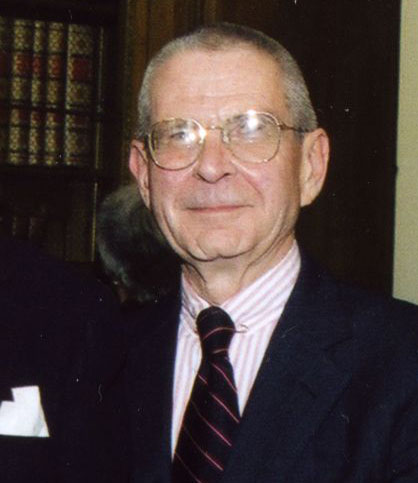
2012
The Archaeological Institute of America is pleased to present its 2012 Conservation and Heritage Management Award for excellence in the conservation of archaeological sites and collections to Professor James R. McCredie. The award is in recognition of Professor McCredie’s lifetime support of conservation in the field as well as his ongoing commitment to conservation training and education.
Professor James R. McCredie is a highly respected scholar and archaeologist, who has held many governing and influential management positions. He was former director of the American School of Classical Studies at Athens (1969-1977), chairman of the Managing Committee of the American School (1980-1990); director of the Institute of Fine Arts, New York University (1983-2002). He has also been the director of the Excavations of The American School of Classical Studies at Athens and the Institute of Fine Arts, New York University, in the Sanctuary of the Great Gods in Samothrace, Greece, from 1961 to the present.
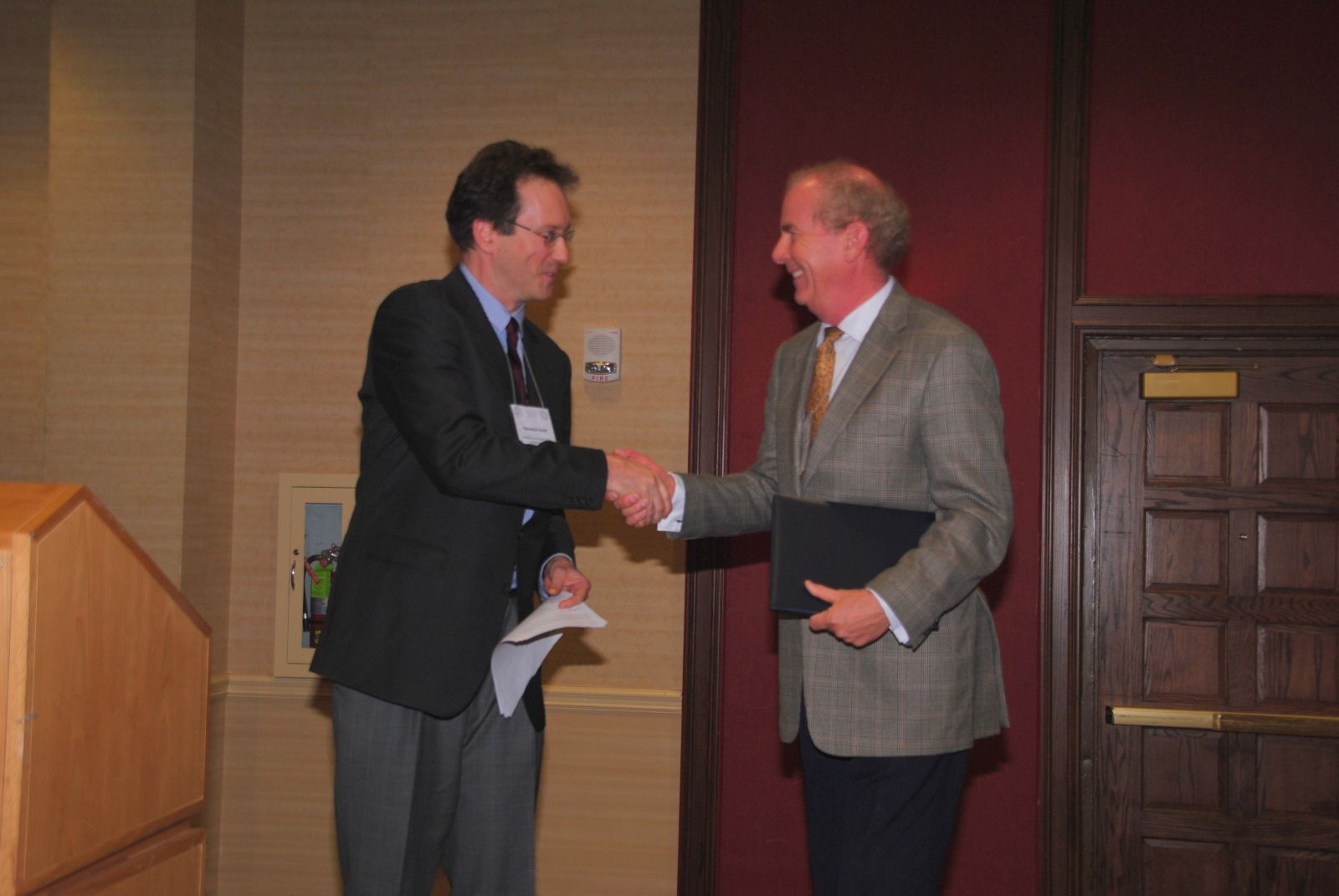
2011
The Archaeological Institute of America is pleased to present its 2011 Conservation and Heritage Management Award for excellence in the conservation of archaeological sites and collections to the Archaeological Conservancy.
Since 1980, under the leadership of founder and president Mark Michel, this nonprofit organization has worked to preserve archaeological heritage by acquiring or assisting in the acquisition of threatened archaeological sites throughout the United States. By partnering with state and local authorities as well as other not-for-profits, the Archaeological Conservancy has protected more than 300 sites. From the East St. Louis mound complex, an important center of the Mississippian culture, to the Erie Canal in New York to Ghost Dance in California, all periods of the nation’s history fall within the Conservancy’s protection.
All the land directly held by the Conservancy is available for study by archaeologists, and many sites have been used in the training of students. The Archaeological Conservancy is a recent recipient of an AIA Site Preservation Grant for the Gault site in central Texas, one of the most prolific Clovis sites in America; their partnering with the Gault School of Archaeological Research for this work ensures ongoing educational efforts. In addition, their active outreach program includes tours, lectures, and the quarterly publication American Archaeology.
On behalf of the Archaeological Institute of America, it is an honor to present the 2011 Conservation and Heritage Management Award to the Archaeological Conservancy. President and CEO Mark Michel will accept the award on behalf of the Archaeological Conservancy.
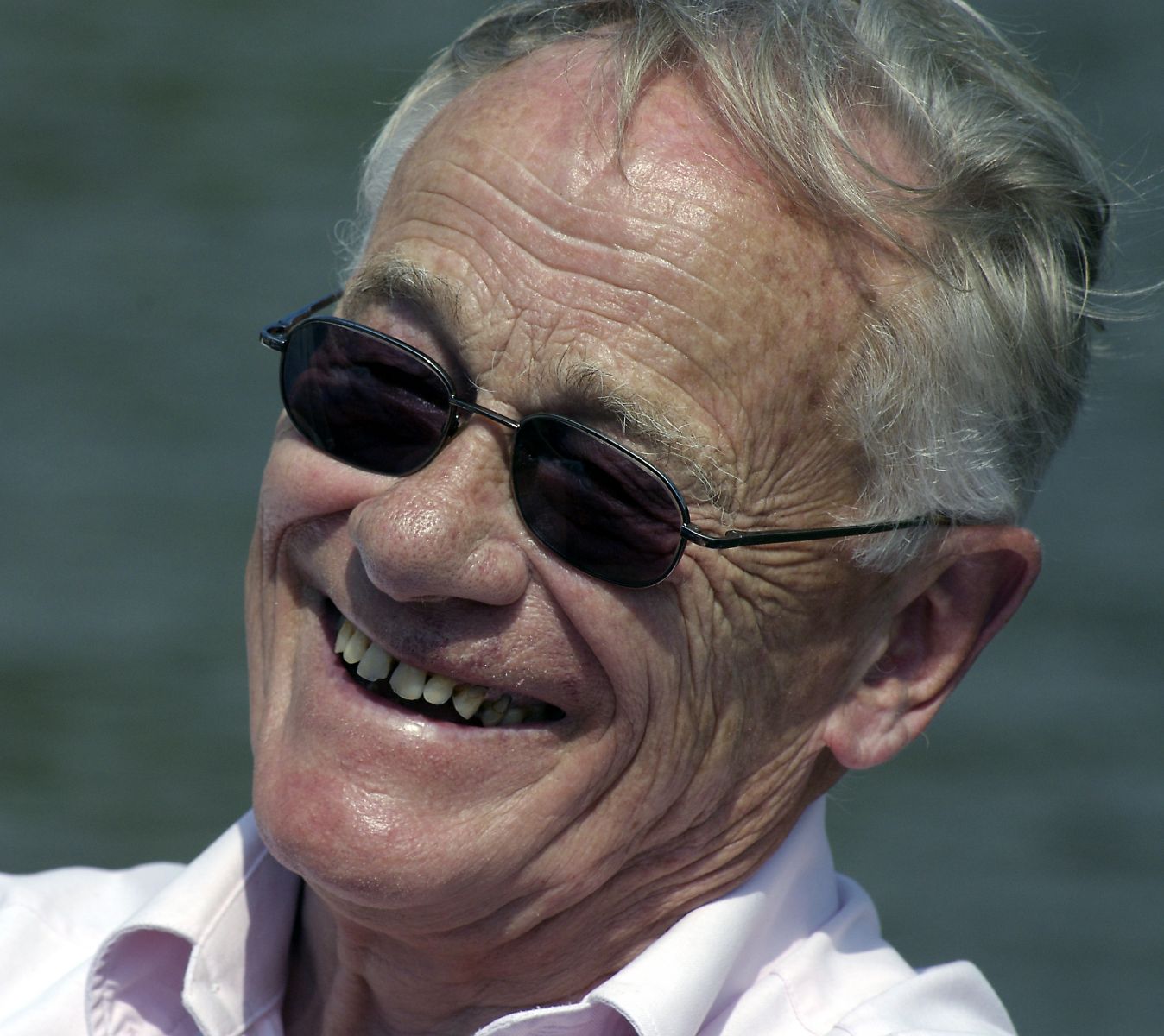
2010
The Archaeological Institute of America is pleased to present its 2010 Conservation and Heritage Management Award for excellence in the conservation of archaeological sites and collections to Henry Cleere.
Cleere is one of the founding figures of the conservation field. His 1984 book Approaches to the Archaeological Heritage (Cambridge and New York 1984) presents archaeological heritage in a comparative, international context for the first time. During his two decades as director of the Council for British Archaeology, his understanding of the critical need for rescue work launched many important initiatives. He helped establish the International Committee for Archaeological Heritage Management (ICAHM) in 1984 and was a leading figure in drafting the 1990 Charter for the Protection and Management of the Archaeological Heritage for the International Council on Monuments and Sites (ICOMOS).
In 1992, he joined the staff of the International Secretariat in Paris as a World Heritage consultant. For more than 10 years, he coordinated all the work of ICOMOS as one of the official advisory bodies to the UNESCO World Heritage Committee, evaluating several hundred cultural properties nominated to the World Heritage List in more than 70 countries. The founding secretary of the European Association of Archaeologists (EAA), he drew on his vast expertise to draft that organization’s statutes and Code of Practice in 1997. More recently, he has consulted for the World Monuments Fund, Global Heritage Fund, and the People’s Republic of China.
On behalf of the Archaeological Institute of America, it is an honor to present the 2010 Conservation and Heritage Management Award to Henry Cleere.
2009
The Archaeological Institute of America is pleased to present its 2009 Conservation and Heritage Management Award for excellence in the conservation of archaeological sites and collections to Heritage Watch, a non-profit organization dedicated to safeguarding Cambodia’s cultural heritage.
Founded in 2003 by Dr. Dougald O’Reilly, Heritage Watch has addressed the major issues that affect archaeological sites in Cambodia as well as worldwide: looting, the trade in illicit antiquities, tourism overload, and rapid development outpacing national policies to protect sites. Their international efforts to protect antiquities include presenting testimony for the Cultural Property Advisory Committee in support of Cambodia’s request for renewal of its bilateral agreement with the United States and garnering thousands of signatures in an online petition to convince the governments of Thailand and Singapore to sign the 1970 UNESCO Convention.
The protection by Heritage Watch of archaeological resources in the ground includes the documentation of sites, identifying at-risk areas, and rescue archaeology at Wat Jas, an Iron Age cemetery. They also track what happens to artifacts once they leave the ground, by monitoring the trade of Cambodian antiquities through auction house sales and on the internet. These efforts are strengthened with heritage training programs (including those for the police), and through published articles aimed directly at collectors and other non-archaeologists on the importance of protecting archaeological objects.
Heritage Watch strategies are aimed at both the supply and the demand end of the antiquities trade. Their innovative use of media includes radio and TV ads, in addition to educational comic books (intended not just for younger audiences but for adults with literacy challenges as well). Their excellent outreach programs include messages in airport kiosks about responsible archaeological tourism as well as at sites throughout the country. An informative website, with everything from recent projects and how visitors can help, to listing ‘Heritage Friendly’ businesses, is user-friendly and compelling.
The outstanding achievements of Heritage Watch offer a compelling example of how to ignite public interest, motivate disparate groups to find solutions and make good use of all available media in order to protect fragile and highly threatened archaeological resources. It serves as both inspiration and practical template; developed with a specific culture in mind but applicable on a global scale.
On behalf of the Archaeological Institute of America, it is an honor to present the 2009 Conservation and Heritage Management Award to Heritage Watch.
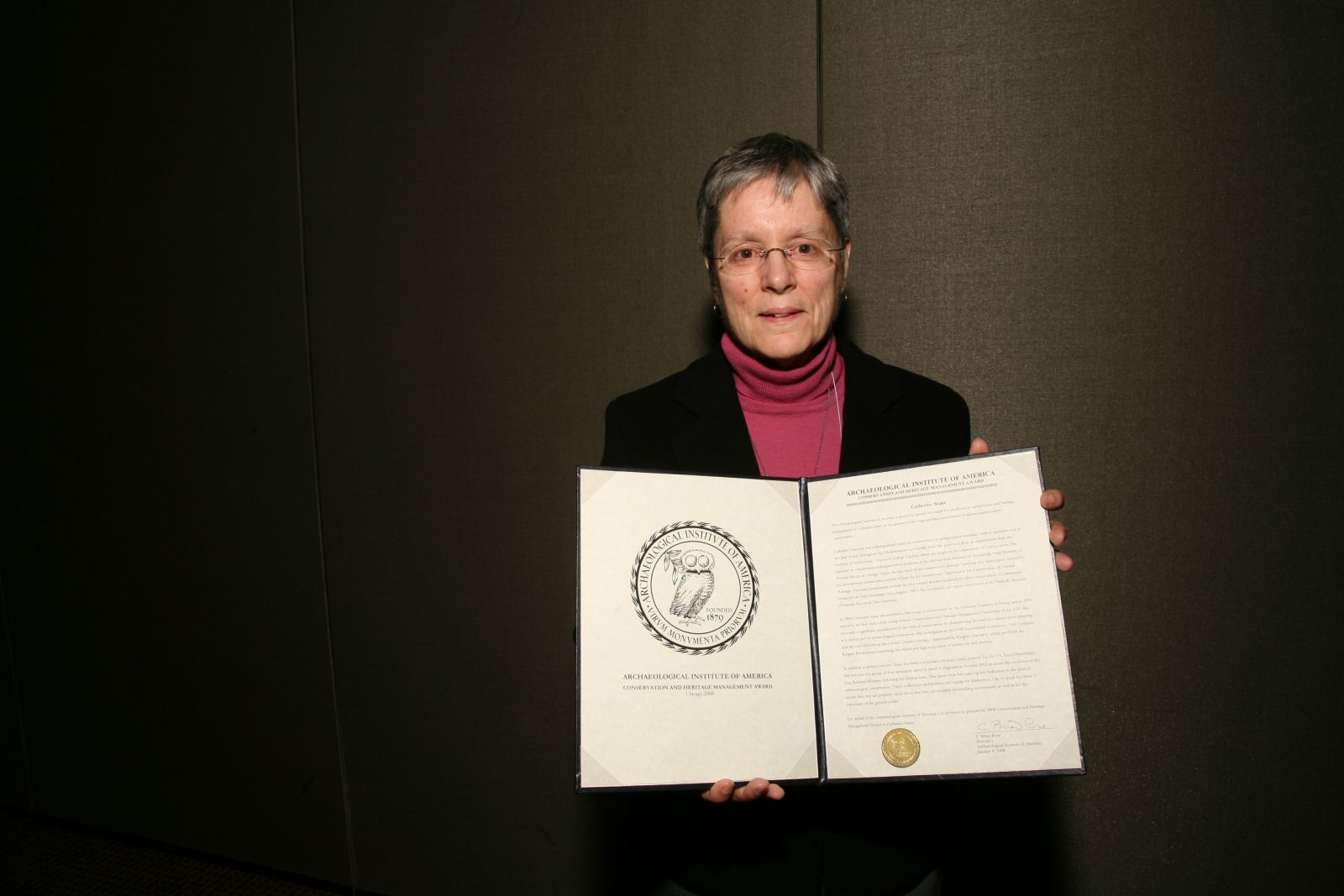
2008
The Archaeological Institute of America is pleased to present its award for excellence in conservation and heritage management to Catherine Sease, in recognition of her long-standing commitment to archaeological artifact conservation.
Catherine Sease has had a distinguished career as a conservator of archaeological materials, both in museums and in the field at sites throughout the Mediterranean and Middle East. She received a B.Sc. in conservation from the Institute of Archaeology, University College London, where she taught in the Department of Conservation. Her expertise in conservation techniques led to positions at the Metropolitan Museum of Art and the Field Museum of Natural History in Chicago, where she was head of the conservation division. Sease has also been a guest instructor for international conservation courses offered by the International Organization for Conservation of Cultural Heritage. Her many publications include the most widely known handbook for field conservation, A Conservation Manual for the Field Archaeologist (Los Angeles 1987). She is currently the senior conservator at the Peabody Museum of Natural History at Yale University.
In 1994, Catherine Sease was awarded a fellowship in conservation by the American Academy in Rome, and in 1995 served as the first chair of the newly formed Conservation and Heritage Management Committee of the AIA. She has made a significant contribution to the field of conservation by championing the need for conservation planning as a critical part of archaeological excavations. She participated in the 1998 international conference, “Art, Antiquity, and the Law: Preserving our Global Cultural Heritage,” sponsored by Rutgers University, which put forth the Rutgers Resolutions concerning the ethical and legal acquisition of ancient art and artifacts.
In addition to private practice, Sease has been a consultant for many years, recently for the U.S. State Department. She was one of a group of four specialists asked to travel to Baghdad in October 2003 to assess the condition of the Iraq National Museum following the looting crisis. This quote from her sums up her dedication to the field of archaeological conservation: “Since collections and artifacts can’t speak for themselves, I try to speak for them. I ensure that they are properly cared for so that they are available for teaching and research, as well as for the enjoyment of the general public.”
On behalf of the Archaeological Institute of America, it is an honor to present the 2008 Conservation and Heritage Management Award to Catherine Sease.
2007
The Archaeological Institute of America is pleased to present its award for outstanding achievement in the conservation of archaeological sites and collections to the Pointe-á-Callière Musée d’archéologie et d’histoire de Montréal in recognition of its accomplishments in the conservation and study of an archaeological and national historic site and its outreach efforts to promote archaeology and conservation to the public. Through publications, collaborative work with other sites, and the hosting of international archaeological exhibits and conferences on historical archaeology, the museum has looked beyond its borders to participate in archaeological and heritage site management on a global scale.
The diverse combination of an important national historic site, the ongoing study of a crypt and excavation site showing continuous usage from the 15th to the 20th centuries, an innovative on-site field school that offers internships and scholarships, artifact conservation (resulting in one of the largest archaeological collections in the country), and an excellent museum featuring in situ remains have all earned the Pointe-à-Callière museum numerous awards in each of these categories.
Under its executive director, Madame Francine Lelièvre, the museum does an exceptional job using multimedia presentations and interactive displays to educate the public on the importance of careful conservation and presentation of archaeological artifacts, highlighting that “[this] work is extremely delicate, for the information [handled] is fragile and non-renewable, while errors are irreversible.” Visitor services provide an accessible and enjoyable experience that encourages participation and repeat visits to take advantage of the many educational outreach programs devoted to archaeology, including the hosting of AIA society lectures.
Located in the heart of a busy urban landscape, this archaeological site and museum showcases the benefits of a cohesive, integrated partnership with multiple government levels in order to protect and invigorate both the site and its setting, including redirected traffic patterns, redevelopment strategies, and architectural policies that incorporate existing historic buildings into the surrounding master plan.
On behalf of the Archaeological Institute of America, it is a privilege to present the 2007 Conservation and Heritage Management Award to the Pointe-á-Callière Musée d’archéologie et d’histoire de Montréal. (Award accepted by Francine Lelièvre, Executive Director)
2006
The Archaeological Institute of America has the honor of presenting the 2006 Conservation and Heritage Management Award to three individuals whose careers have advanced the investigation, interpretation, and protection of archaeological sites, collections, and records in the United States. The combined work of Hester A. Davis, William Lipe, and Charles R. McGimsey, III, has influenced archaeological and cultural resource management practices extending well beyond national borders.
Hester A. Davis is a national leader in the organization of state and local advocates for archaeological resource protection. She has worked tirelessly for the development and implementation of volunteer archaeology programs at both the local and national level. Her work has focused attention on destruction as part of publicly funded and/or permitted activities. William Lipe presented a view of archaeological sites as a non-renewable resource to be not only investigated, but also preserved. After co-organizing the first national Cultural Resource Management meeting, he co-authored the first detailed text on the theory, legal basis, method, and practice of what has become CRM policy. Charles R. McGimsey, III has led the effort to professionalize the archaeological discipline, by creating and enforcing professional ethics and standards. He has directed efforts to expand federal responsibilities to take into account the archaeological resources that are affected by federal construction projects and those funded, permitted, or licensed by federal agencies.
These three individuals have been articulate and vocal advocates for protecting the archaeological record, and have been instrumental in continuing the work started one hundred years ago with the 1906 American Antiquities Act. In recognition of this important anniversary, the Archaeological Institute of America is pleased to honor Hester A. Davis, William Lipe, and Charles R. McGimsey, III for their collective accomplishments. Together, their work and publications have had a significant impact upon archaeological heritage management practices within the United States, as well as contributing to the study of the field throughout the world.
On behalf of the Archaeological Institute of America, it is a privilege to present the 2006 Conservation and Heritage Management Award to Hester A. Davis, William Lipe, and Charles R. McGimsey, III.
2005
The Archaeological Institute of America is pleased and honored to present its award for outstanding achievement in the area of conserving archaeological sites and collections to the team of the Underwater Archaeological Services – Parks Canada Agency, les Services d’Archéologie Subaquatique –Agence Parcs Canada, under the direction of its Chief Archaeologist, Robert Grenier.
UAS – Parks Canada has made exceptional contributions to the field of underwater archaeology and heritage management, setting new standards for the conservation of submerged cultural resources. Their remarkable project excavating and conserving a 16th century Basque whaling galleon at Red Bay, Labrador, integrated data from both terrestrial and underwater archaeology in an extensive undertaking which remains an international model for excavation, documentation and conservation, including the study of thousands of timber pieces on the ocean floor. Not only did the team develop new methods of carefully protecting and transporting fragile artifacts to be sent to conservation laboratories, but they also added a new conception of conservation with their decision to re-bury the completely disassembled shipwreck for its best protection, after highly sophisticated recording. Now resting on the ocean floor close to where it first sank over four centuries ago, this ship has become a world symbol as UNESCO’s permanent logo for heritage shipwrecks.
The Red Bay project is one in a long line of groundbreaking achievements, including the excavations of the French frigate Le Machault, the wrecks of the Célèbre and the Prudent at Louisbourg National Historic Park, and the Elizabeth and Mary, an American troop ship sunk shortly after the 1690 siege of Québec City.
Under the leadership of Robert Grenier since 1979, UAS – Parks Canada has helped change the focus on underwater sites from one of treasure-oriented looting and exploitation to one of sound archaeological research and scientific knowledge. The UAS team has demonstrated a deep and lasting commitment to insuring the permanent protection of all underwater cultural patrimony.
On behalf of the Archaeological Institute of America, it is a privilege to present the 2005 Conservation and Heritage Management Award to les Services d’Archéologie Subaquatique –Agence Parcs Canada, the Underwater Archaeological Services – Parks Canada Agency.
2004
The Archaeological Institute of America is pleased and honored to present its award for outstanding achievement in the area of conserving archaeological sites and collections to Dr. Nicholas P. Stanley-Price, Director-General of ICCROM (International Centre for the Study of the Preservation and Restoration of Cultural Property).
Nicholas Stanley-Price is widely considered to be the most accomplished and influential figure in the field of archaeological site conservation today. He earned this position through his dedication to this topic since the early 1980’s when he coordinated the first international workshop on this topic in Nicosia, Cyprus, which resulted in ICCROM’s seminal publication entitled Conservation on Archaeological Excavations. Holding a D.Phil. in Archaeology from Oxford University (1976), and having subsequently gained considerable training and experience in conservation science, Dr. Stanley-Price has almost unique qualifications for his specialty in conserving and presenting archaeological sites and related matters. He has published numerous articles and has served as editor for several journals and special publications that have done much to soundly and properly place archaeological conservation within the general field of cultural heritage management. Seeing the need for a specialty publication in this profoundly important and relevant subject, Dr. Stanley-Price has served as founder and editor since 1996 of the journal Conservation and Management of Archaeological Sites (James & James Ltd., London) that regularly offers the most current thinking in the field today.
Through his role as deputy director of the Training Program at the Getty Conservation Institute from 1987- 1995, his teaching and administrative roles at the Institute of Archaeology at the University College London (1998-2000), and since 2000 as Director-General of ICCROM, Dr. Stanley-Price has been influential in implementing constructive action in conserving archaeological sites throughout the world and in educating a considerable number of students and colleagues. His numerous consultancies to various organizations and his first hand involvement at a number of archaeological sites are testament to his commitment and approach to addressing real problems in archeological conservation.
As all archaeologists and conservation professionals know, the task of conserving archaeological sites and artifacts represents one of greatest challenges faced in the entire field of heritage conservation. Despite the myriad physical and technical difficulties that are often encountered with this special facet of both archaeology and conservation, Dr. Nicholas Stanley-Price has steadfastly and constructively worked in this most difficult of specialties and has significantly advanced its progress for over two decades.
On behalf of the Archaeological Institute of America it is a special pleasure to award this much-deserved 2004 Conservation and Heritage Management Award to Dr. Nicholas Stanley-Price.
2002
The Governing Board of the Archaeological Institute of America is pleased to present the 2002 Conservation and Heritage Management Award to the Wet Organic Archaeological Materials Working Group (WOAM) of the International Committee on Conservation Committee for Conservation (ICOM-CC). Over the past 20 years, WOAM has met regularly to report on research on the conservation of wet archaeological materials that has taken place since the previous meeting. The scope of their work includes not only artifacts, but sites and site monitoring as well. As part of the proceedings, the group sets a research agenda for future work that various members agree to pursue. In this way, current research builds on previous work and determines areas of future work. This serves to reduce redundancy in conservation research as well as target areas of particular concern. The Group has been responsible for the great strides that have been made in recent years in the understanding and treatment of wet and waterlogged archaeological materials and is therefore deserving of recognition.
2001
The Museum of London is the 2001 recipient of the Archaeological Institute of America’s Conservation and Heritage Management Award. This award was instituted in 1998 to recognize the exceptional achievement of an individual or an institution in the areas of archaeological conservation, conservation science, heritage management, or education and public awareness of archaeological conservation through teaching, lecturing, exhibitions, or publications. For many years, the Museum of London has devoted considerable time, effort and resources in many of these areas and is deservedly this year’s honore
The Museum of London was formed in 1976, from the merger of the Guild Hall Museum and London Museum, through the encouragement of Sir Mortimer Wheeler. It cares for vast archaeological collections excavated in London and is the largest and most comprehensive city museum in the world, with 14 Galleries devoted to the fascinating story of London from prehistoric times to the present.
Over the years, the Museum of London has made a strong and consistent commitment to historic and archaeological conservation, promoting conservation as a vital function of all its activities, both in the field, as in the “Save the Rose” theater project, and in the museum in its displays and installations. The Museum has consistently emphasized the importance of conservation in its educational and public outreach efforts, perhaps most spectacularly demonstrated in its recent Spitalfields sarcophagus project (1999–2000). By excavating, cleaning and conserving the sarcophagus, its skeleton and associated grave goods in an exhibit gallery, the Museum allowed the public to see how archaeology and conservation are done and participate in the process, demonstrating how important conservation is not only in preserving the past, but also in interpreting it. Not surprisingly, this was one of the Museum’s all-time most popular exhibits, with lines of visitors waiting to file past the conservators at work.
Two special collections cared for by the Museum are the Greater London Archaeological Archive, which contains the objects and records from excavations in London over the past 50 years, and the Port and River Collection, which will be displayed in the new Museum in Docklands. The Museum of London has taken a leadership role in presenting the various aspects of archaeological conservation to the public and thereby raising public awareness of the excitement and importance of saving our cultural heritage.
1999
The Archaeological Institute of America is proud to present the 1999 Conservation and Heritage Management Award to Lawrence J. Majewski. This award was instituted in 1998 to recognize the exceptional achievement of an individual or an institution in the areas of archaeological conservation, conservation science, heritage management, or education and public awareness of archaeological conservation through teaching, lecturing, exhibitions, or publications. Larry Majewski has devoted most of his life to all of these fields and, deservedly, is this year’s honoree.
Larry Majewski was born in 1919 and studied chemistry and biology before entering service during World War II. After the war, he turned to studies in art and completed his B.F.A. and M.F.A at Yale University. His dual interests in art and conservation led him first into paintings conservation at the Metropolitan Museum of Art in 1952. In 1953 he was recruited by Murray Pease to help with the conservation of the Byzantine Mosaics in Istanbul, which led to his appointment as Deputy Director of the Byzantine Institute of America in Istanbul, Turkey from 1956–1960.
In 1960 he returned to the United States to join the staff of the Conservation Center, Institute of Fine Arts (IFA), New York University, the first degree-granting American conservation training program. He was appointed Chairman of the Conservation Center in 1966 and actively served as a member of the staff until his retirement in 1986. Since 1986 he has continued to teach and advise students at the IFA in his role as the Hagop Kevorkian Professor Emeritus of Conservation and Adjunct Professor of Conservation.
Throughout his career, Professor Majewski provided advice, support, and service to a variety of projects that were important to the emerging field of art and archaeological conservation. In 1966 he organized and led a group of 17 American conservators to aid the rescue effort just after the devastating flood in Florence. In 1971, when the U.S. formally joined ICCROM, he served as the U.S. delegate. In 1971 he was signatory to the by-laws of the newly founded American Institute of Conservation of Historic and Artistic Works (AIC) and worked for years on its incorporation.
Professor Majewski’s contributions to the field of archaeology and heritage management are also numerous. In 1964 he was appointed Chief Conservator of the archaeological expedition to Sardis for Harvard University. He kept that position for 25 years, lecturing and teaching dozens of students in the field. He served as a consultant to a wide variety of international projects, including the Buddhist Shrine of Borobodur (Indonesia) in 1973 and the Ajanta Caves (India) in 1975, and was advisor to numerous projects in Venice and Poland. He also actively worked as a member of the ICOM Working Group on Icons and the ICCROM Group on mosaics, as well as acted as editor for Art and Archaeology Technical Abstracts for almost two decades. He has been a Fellow of the International Institute for Conservation (IIC) for over 30 years and was appointed Honorary Fellow of AIC in 1987. He has also been an affiliate of numerous organizations, including a member of the AAM and the AIA. In addition he found time to contribute to his local community near Wappinger Falls, New York, where he was president of the Bowdoin Park Historical and Archaeological Association from 1986 to 1990.
Through his teaching, Professor Majewski generously shared his knowledge, experience, and interests with hundreds of students who fondly remember him. He has numerous lectures and publications to his credit on field conservation and monument and site management. He gave to his students a thorough understanding of technology and materials science as well as an abiding joy and pleasure in art. His students have not all become conservators-many have gone on to be scientists, curators, art historians, artists, or administrators-a fact that reflects on his enormous love and ability for the new and unknown directions that life can take. His contributions to the fields of conservation and archaeology will be seen through these future generations for decades to come.
In recognition of a lifetime of contributions to the field of conservation and archaeology, the Archaeological Institute of America is pleased to present the 1999 Conservation Award to Professor Larry J. Majewski.
1998
The Department of Conservation at the Institute of Archaeology, University College London, is the 1998 recipient of the Archaeological Institute of America’s Conservation and Heritage Management Award. This is a newly instituted award to recognize exceptional achievement in the areas of archaeological conservation, conservation science, heritage management, or education and public awareness of archaeological conservation through teaching, lecturing, exhibitions, and publications.
When the Institute of Archaeology was formally opened in 1937, the rudiments of a conservation program were already in place. Ione Gedye was hired on a part-time basis to mend pots and talk to students about what she was doing and why. Slowly her informal lectures developed into courses and archaeology students came to learn the theory behind treatment as well as to receive practical experience in the treatment of artifacts. Gradually, conservation laboratories were properly equipped. After World War II, the program began to attract students specifically studying conservation and the Department of Conservation came into its own. Initially, the course was a one-year certificate program. Later it became a two-year course, then a three-year course. Finally, in the 1970s, the three-year course was turned into a degree course.
Over the past 60 years, the Institute’s Conservation program has been unique in devoting itself exclusively to the training of archaeological conservators. Coming from many different countries, its graduates have been instrumental in establishing and practicing conservation on excavations around the world, and caring for some of the world’s most important cultural heritage. In addition, many graduates hold positions in museums internationally and have been directly responsible for establishing conservation in these institutions. Some have assumed responsibilities in museum administrations where they have successfully advocated the importance of conservation and collections care in the museum’s daily activities. Others have gone on to establish training programs that have carried on the Institute’s tradition of training archaeological conservators.
In addition to training conservators, the Department of Conservation has continued its early practice of providing archaeology students (and for the last ten years, museum studies students) with a basic course in the principles and theory of archaeological conservation. Over the years, this has served to provide a common ground for conservators, archaeologists, and museum curators, facilitating communication and understanding that has resulted in the better long-term care of our cultural heritage.
It can be argued that in its 60 years of training archaeological conservators, the Department of Conservation of the Institute of Archaeology has been largely responsible for defining the discipline of archaeological conservation and determining its direction. In recognition of this achievement, the Archaeological Institute of America is proud to present this award.
Notifications